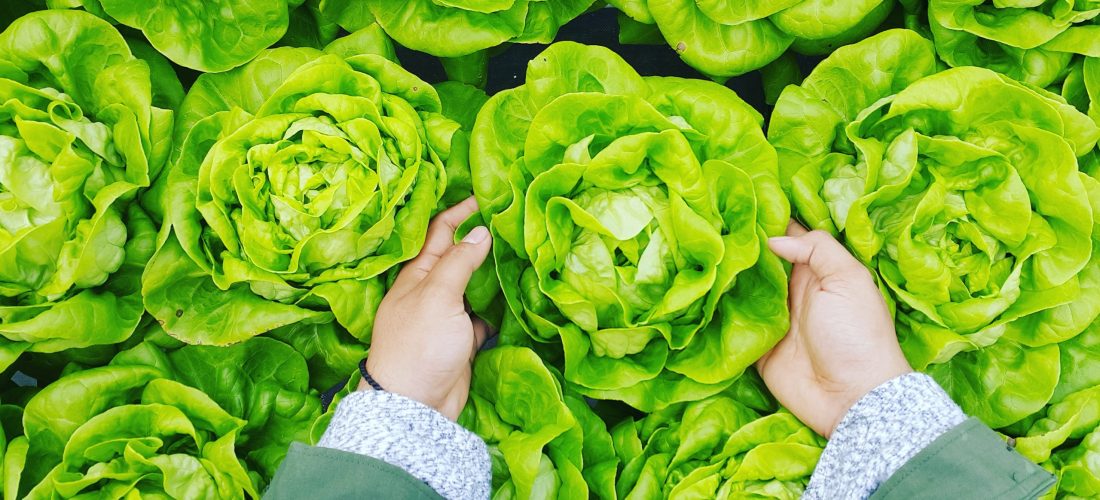Plant pests and disease management in an aquaponics system
October 07, 2021
One of the biggest headaches you’ll get as an aquaponics farmer is a constant struggle with pests and disease in your plants. Some are just unavoidable but others can be prevented and managed to ensure that your crop loss is little to none. Let’s walk you through some of our methods for plant pests and disease management in an aquaponics system.
Spray Routines
Before you panic, we want to remind you that any sprays, treatments or supplements are completely organic. This is because whatever we put on the plants will also be circulated to our fish and beneficial bacteria. Therefore, we need to be careful not to harm them or upset the balance in the system.
We like to work with three management categories with our spray routines.
Preventative Spray Regime
This is a daily broad-spectrum spray for all fungi and pests that may creep their way into our system. The goal of this regime is to prevent any disease or pest issues before they happen.
Reactive Spray Regime
Once daily inspections have taken place if any issues are detected or alarming we instantly react with this spray regime. This is a more aggressive spraying regime and it is applied until the issue is resolved.
Targeted Spray Regime
We like to use this as a last resort as these sprays can become toxic to fish in high quantities. This regime is very aggressive and we only spray this over 5-10% of plant foliage at targeted problem areas. This is not a broad-spectrum spray.

Pest Management in an Aquaponics System
Neem Oil
We like to use Neem Oil as a preventative and reactive regime. Neem Oil is an effective organic pesticide as it either deters pests from its strong smell or the insects are driven away after eating leaves that have been sprayed with Neem Oil.
Targeted Pests
- Fruit flies
- Whiteflies
- Weevils
- Leafhoppers
- Mealybugs
Pyrol Oil
We like to use this as a broad-spectrum preventative spray as well as a reactive and targeted in some cases. Pyrol Oil is made up of naturally occurring plant oils that are then used as active ingredients to kill off insects at every stage of their lifecycle.
Targeted pests
- Aphids
- Beetles
- Caterpillars
- Ants
- Mealybugs
- Mites
- Leafhoppers
- Scale
Tomato Leaf Spray
We like to use this spray as a broad-spectrum preventative regime. Tomato leaves contain alkaloids that are toxic to certain aphids while still being safe to use in an aquaponics system.
Targeted Pests
- Aphids
- Plant Lice
White Oil
White Oil is an effective spray that we like to use in both preventative and reactive situations. It is effective in suffocating soft-bodied insects and makes for a great organic insecticide.
Targeted Pests
- Aphids
- Mites
Eco Insect Control
This is ONLY a targeted regime. Try to hold off on using this unless absolutely necessary. This solution works through both ingestion and contact exposure. This can be toxic to fish in high quantities, so be careful.
Targeted Pests
- Leafminer
- Bollworm
- Thrips
Disease Management in an Aquaponics System
Milk
Milk can be used as a preventative and reactive spray to combat fungi and mildew issues. We like to use a mixture of three parts milk to two parts water.
Sulphur
This is a targeted only regime. Sulphur stops the fungal spores from germinating, therefore, disrupting the replication process.
Amylo X
This is a bio-fungicide that is quite effective in controlling powdery mildew. It contains bacteria that produces anti-fungal compounds. This active ingredient makes the treatment highly successful in most cases of mildew. You can use this as a preventative, reactive and targeted spraying regime.
Copper Soap
This solution is best applied as a preventative spray however, it can also be used as a reactive spray. Copper soap is effective in controlling powdery mildew, rusts, black spot, leaf and fruit rot, downy mildew, and late blight.
Potassium Carbonate
We use this regime in preventative and reactive situations. Potassium Carbonate interrupts the development of fungal mycelium. It makes for a great alternative to sulphur and copper fungicides.
Integrated Pest Management Programme
We believe that it’s always a good idea to have an IPM Programme in place.
Pest Focal Plants
This method entails companion planting of pest attracting plants to deter from attracting the pests to your produce. Some plants you could use here are sunflowers, maize, marigold and mustard plants.
Pest Deterrent Plants
Companion planting to deter pests from the area. Some strong-smelling plants will do the trick here like, coriander and mint.
There are many ways to organically carry out plant pests and disease management in an aquaponics system. We strongly believe that it’s better to prevent a problem than try to solve one. So, make sure you set up and implement a strict preventative spraying regime. If you require some assistance make sure to book a consultation with us, we would be happy to give you some advice.
Good luck!